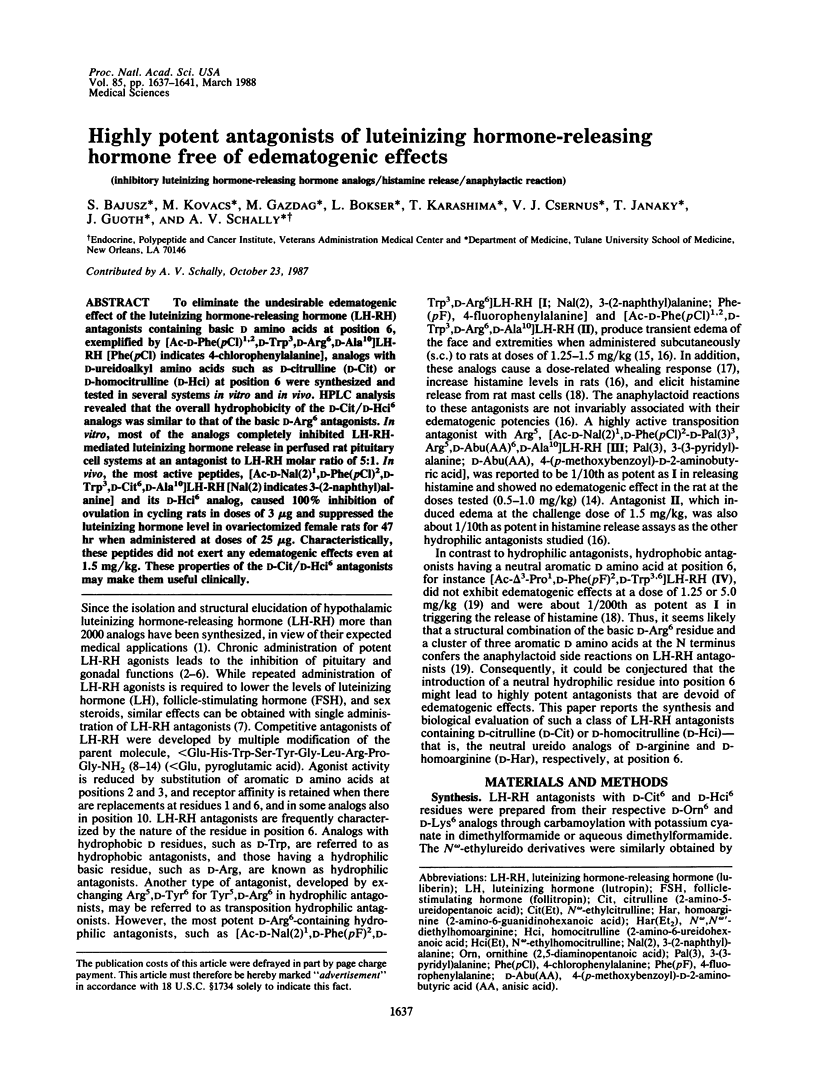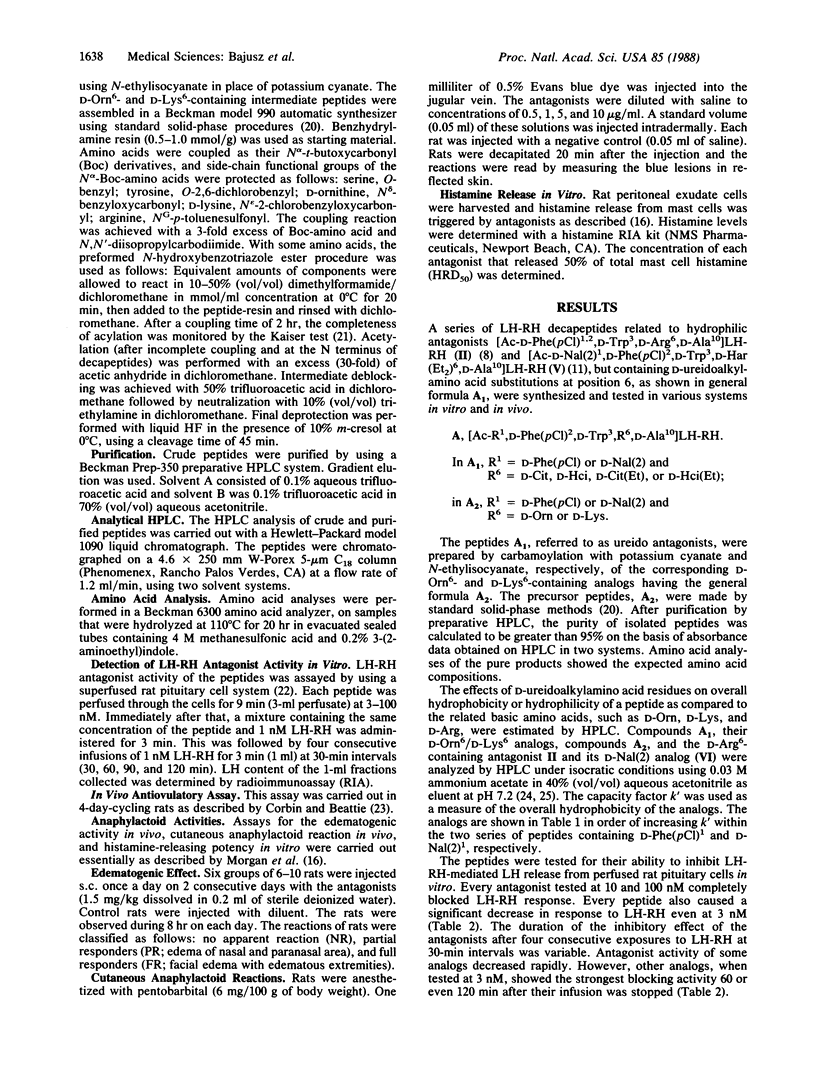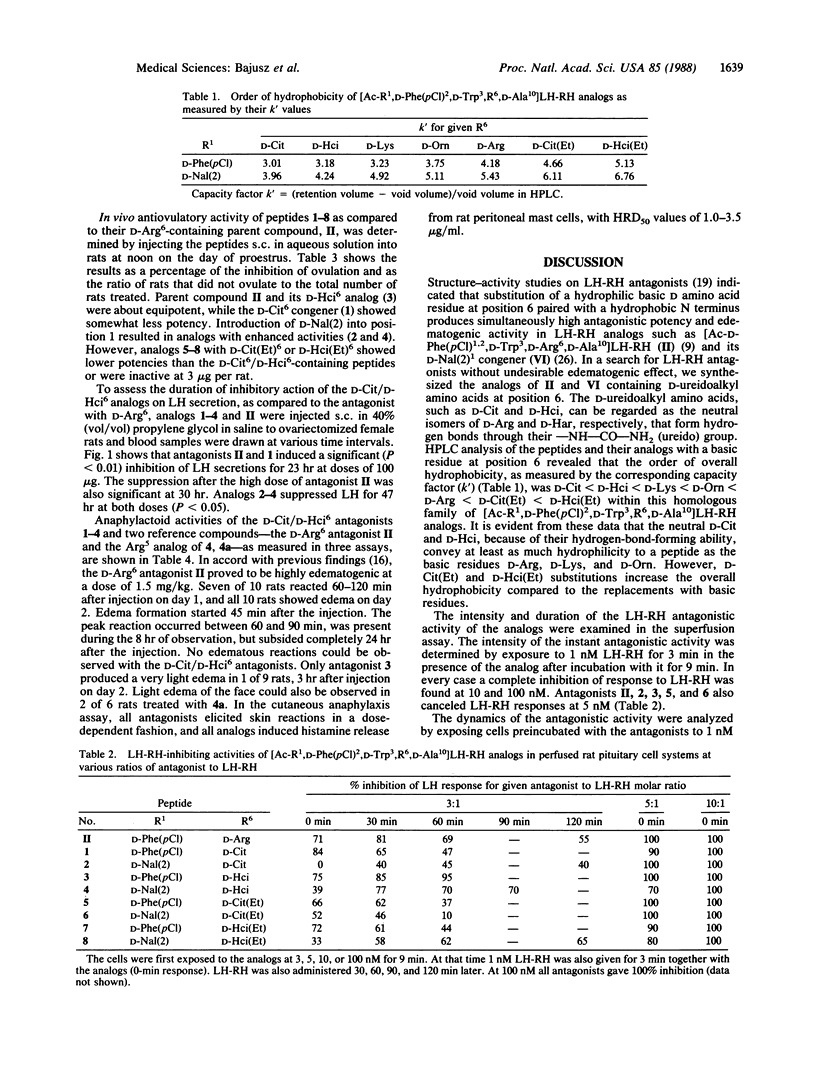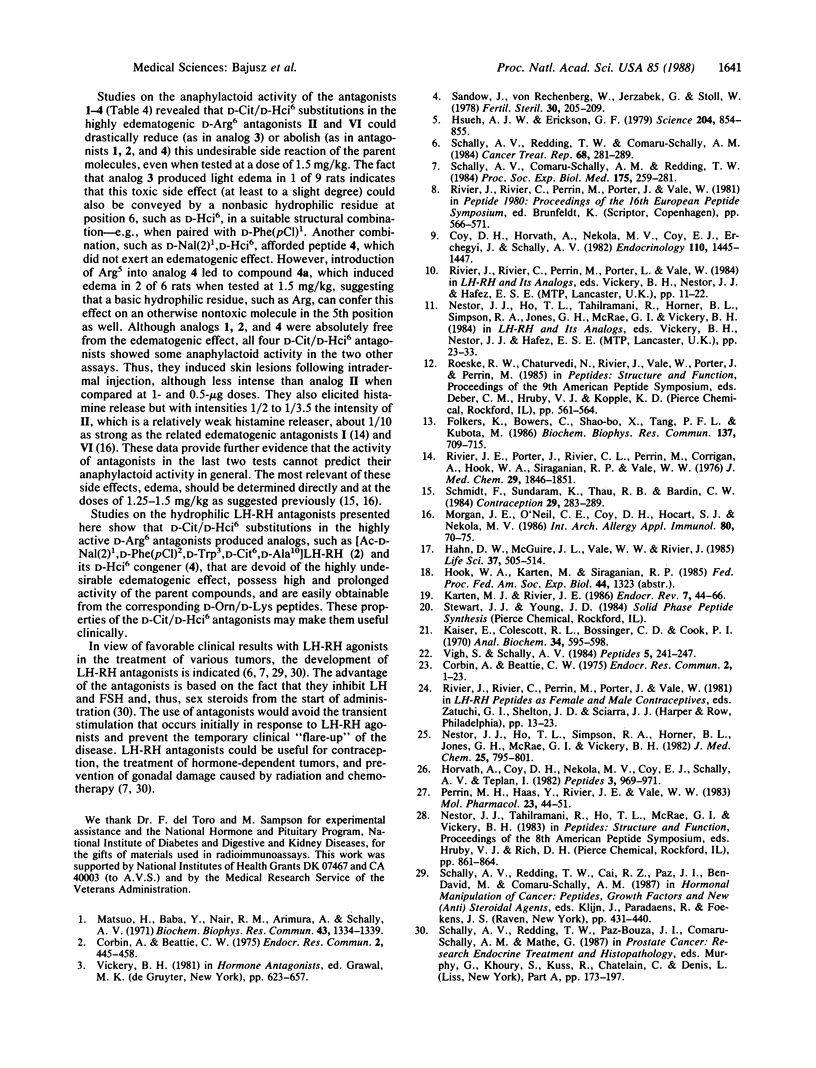Abstract
To eliminate the undesirable edematogenic effect of the luteinizing hormone-releasing hormone (LH-RH) antagonists containing basic D amino acids at position 6, exemplified by [Ac-D-Phe(pCl)1,2,D-Trp3,D-Arg6,D-Ala10]LH-RH [Phe(pCl) indicates 4-chlorophenylalanine], analogs with D-ureidoalkyl amino acids such as D-citrulline (D-Cit) or D-homocitrulline (D-Hci) at position 6 were synthesized and tested in several systems in vitro and in vivo. HPLC analysis revealed that the overall hydrophobicity of the D-Cit/D-Hci6 analogs was similar to that of the basic D-Arg6 antagonists. In vitro, most of the analogs completely inhibited LH-RH-mediated luteinizing hormone release in perfused rat pituitary cell systems at an antagonist to LH-RH molar ratio of 5:1. In vivo, the most active peptides, [Ac-D-Nal(2)1,D-Phe(pCl)2,D-Trp3,D-Cit6,D-Ala10]LH-RH [Nal(2) indicates 3-(2-naphthyl)alanine] and its D-Hci6 analog, caused 100% inhibition of ovulation in cycling rats in doses of 3 micrograms and suppressed the luteinizing hormone level in ovariectomized female rats for 47 hr when administered at doses of 25 micrograms. Characteristically, these peptides did not exert any edematogenic effects even at 1.5 mg/kg. These properties of the D-Cit/D-Hci6 antagonists may make them useful clinically.
Full text
PDF




Selected References
These references are in PubMed. This may not be the complete list of references from this article.
- Corbin A., Beattie C. W. Ihibition of the pre-ovulatory proestrous gonadotropin surge, ovulation and pregnancy with a peptide analogue of luteinizing hormone releasing hormone. Endocr Res Commun. 1975;2(1):1–23. doi: 10.3109/07435807509053836. [DOI] [PubMed] [Google Scholar]
- Corbin A., Beattie C. W. Post-coital contraceptive and uterotrophic effects of luteinizing hormone releasing hormone. Endocr Res Commun. 1975;2(6-7):445–458. doi: 10.1080/07435807509084166. [DOI] [PubMed] [Google Scholar]
- Coy D. H., Horvath A., Nekola M. V., Coy E. J., Erchegyi J., Schally A. V. Peptide antagonists of LH-RH: large increases in antiovulatory activities produced by basic D-amino acids in the six position. Endocrinology. 1982 Apr;110(4):1445–1447. doi: 10.1210/endo-110-4-1445. [DOI] [PubMed] [Google Scholar]
- Folkers K., Bowers C., Xiao S. B., Tang P. F., Kubota M. Increased potency of antagonists of the luteinizing hormone releasing hormone which have D-3-Pal in position 6. Biochem Biophys Res Commun. 1986 Jun 13;137(2):709–715. doi: 10.1016/0006-291x(86)91136-8. [DOI] [PubMed] [Google Scholar]
- Hahn D. W., McGuire J. L., Vale W. W., Rivier J. Reproductive/endocrine and anaphylactoid properties of an LHRH-antagonist, ORF 18260 [Ac-DNAL1(2), 4FDPhe2,D-Trp3,D-Arg6]-GnRH. Life Sci. 1985 Aug 12;37(6):505–514. doi: 10.1016/0024-3205(85)90462-x. [DOI] [PubMed] [Google Scholar]
- Horvath A., Coy D. H., Nekola M. V., Coy E. J., Schally A. V., Teplan I. Synthesis and biological activity of LH-RH antagonists modified in position 1. Peptides. 1982 Nov-Dec;3(6):969–971. doi: 10.1016/0196-9781(82)90066-3. [DOI] [PubMed] [Google Scholar]
- Hsueh A. J., Erickson G. F. Extrapituitary action of gonadotropin-releasing hormone: direct inhibition ovarian steroidogenesis. Science. 1979 May 25;204(4395):854–855. doi: 10.1126/science.375393. [DOI] [PubMed] [Google Scholar]
- Kaiser E., Colescott R. L., Bossinger C. D., Cook P. I. Color test for detection of free terminal amino groups in the solid-phase synthesis of peptides. Anal Biochem. 1970 Apr;34(2):595–598. doi: 10.1016/0003-2697(70)90146-6. [DOI] [PubMed] [Google Scholar]
- Karten M. J., Rivier J. E. Gonadotropin-releasing hormone analog design. Structure-function studies toward the development of agonists and antagonists: rationale and perspective. Endocr Rev. 1986 Feb;7(1):44–66. doi: 10.1210/edrv-7-1-44. [DOI] [PubMed] [Google Scholar]
- Matsuo H., Baba Y., Nair R. M., Arimura A., Schally A. V. Structure of the porcine LH- and FSH-releasing hormone. I. The proposed amino acid sequence. Biochem Biophys Res Commun. 1971 Jun 18;43(6):1334–1339. doi: 10.1016/s0006-291x(71)80019-0. [DOI] [PubMed] [Google Scholar]
- Morgan J. E., O'Neil C. E., Coy D. H., Hocart S. J., Nekola M. V. Antagonistic analogs of luteinizing hormone-releasing hormone are mast cell secretagogues. Int Arch Allergy Appl Immunol. 1986;80(1):70–75. doi: 10.1159/000234028. [DOI] [PubMed] [Google Scholar]
- Nestor J. J., Jr, Ho T. L., Simpson R. A., Horner B. L., Jones G. H., McRae G. I., Vickery B. H. Synthesis and biological activity of some very hydrophobic superagonist analogues of luteinizing hormone-releasing hormone. J Med Chem. 1982 Jul;25(7):795–801. doi: 10.1021/jm00349a006. [DOI] [PubMed] [Google Scholar]
- Perrin M. H., Haas Y., Rivier J. E., Vale W. W. Gonadotropin-releasing hormone binding to rat anterior pituitary membrane homogenates. Comparison of antagonists and agonists using radiolabeled antagonist and agonist. Mol Pharmacol. 1983 Jan;23(1):44–51. [PubMed] [Google Scholar]
- Rivier J. E., Porter J., Rivier C. L., Perrin M., Corrigan A., Hook W. A., Siraganian R. P., Vale W. W. New effective gonadotropin releasing hormone antagonists with minimal potency for histamine release in vitro. J Med Chem. 1986 Oct;29(10):1846–1851. doi: 10.1021/jm00160a008. [DOI] [PubMed] [Google Scholar]
- Sandow J., Von Rechenberg W., Jerzabek G., Stoll W. Pituitary gonadotropin inhibition by a highly active analog of luteinizing hormone-releasing hormone. Fertil Steril. 1978 Aug;30(2):205–209. doi: 10.1016/s0015-0282(16)43461-8. [DOI] [PubMed] [Google Scholar]
- Schally A. V., Comaru-Schally A. M., Redding T. W. Antitumor effects of analogs of hypothalamic hormones in endocrine-dependent cancers. Proc Soc Exp Biol Med. 1984 Mar;175(3):259–281. doi: 10.3181/00379727-175-41797. [DOI] [PubMed] [Google Scholar]
- Schally A. V., Redding T. W., Comaru-Schally A. M. Potential use of analogs of luteinizing hormone-releasing hormones in the treatment of hormone-sensitive neoplasms. Cancer Treat Rep. 1984 Jan;68(1):281–289. [PubMed] [Google Scholar]
- Schmidt F., Sundaram K., Thau R. B., Bardin C. W. [Ac-D-NAL(2)1,4FD-Phe2,D-Trp3,D-Arg6]-LHRH, a potent antagonist of LHRH, produces transient edema and behavioral changes in rats. Contraception. 1984 Mar;29(3):283–289. doi: 10.1016/s0010-7824(84)80008-6. [DOI] [PubMed] [Google Scholar]
- Vigh S., Schally A. V. Interaction between hypothalamic peptides in a superfused pituitary cell system. Peptides. 1984;5 (Suppl 1):241–247. doi: 10.1016/0196-9781(84)90282-1. [DOI] [PubMed] [Google Scholar]


